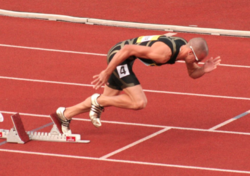Track Running
 An athlete starts to run his track. By pushing back on a fixed block, the runner causes the block to push forward on him. Then, which of Newton's laws can explain this force that initially accelerates the athlete in the forward direction?
An athlete starts to run his track. By pushing back on a fixed block, the runner causes the block to push forward on him. Then, which of Newton's laws can explain this force that initially accelerates the athlete in the forward direction?
This section requires Javascript.
You are seeing this because something didn't load right. We suggest you, (a) try
refreshing the page, (b) enabling javascript if it is disabled on your browser and,
finally, (c)
loading the
non-javascript version of this page
. We're sorry about the hassle.
10 solutions
Can it not be explained in terms of conservation of momentum?
Third law: Each action has an opposite and equal reaction.
He initially pushes the block back, which also pushes back on the runner's foot, but in the opposite direction. This gives him the initial acceleration. This can be explained by Newton's third law of motion.
By using Newton's Third Law, which states every action has a reaction. So if the runner pushes back against the fixed block, he can gain more momentum and acceleration.
A/C to Newton's third law, The fixed block applies an equal and opposite force on the athlete's foot. As such the athlete is able to push forward. Note: 3rd law of Newton states that every action has an equal and opposite reaction.
Newton's Law III (reaction) At the time of repulsion on the starting blocks: the style is done will result in reverse force on the starting blocks.
Description: when the feet do repulsion in the starting blocks, then the beam will start by holding the opposite reaction so that athletes can depart well. The reaction will be even greater if the foot gives a strong repulsion anyway.
unfortunately newton has not made the fourth law of motion so third law says that every action has an equal and opposite reaction when an athelete apply force on that bar an equal and opposite force is give back by the bar so he gets a good start for the race
LOL!!!!!!!!!!!!!!!!!!Can anybody please explain about Newton's fourth law???
Um.... It doesn't exist? XD
Sometimes the Newton's law of gravitation is considered the 4th law, which is: \ F G = r 2 G m 1 m 2
Intialy he put a pressure on the block then the block opposite this reaction at his leg "for every action there is an equal and opposite reaction"
By using Newton's Third Law, which states every action has a reaction. So if the runner pushes back against the fixed block, he can gain more momentum and acceleration.